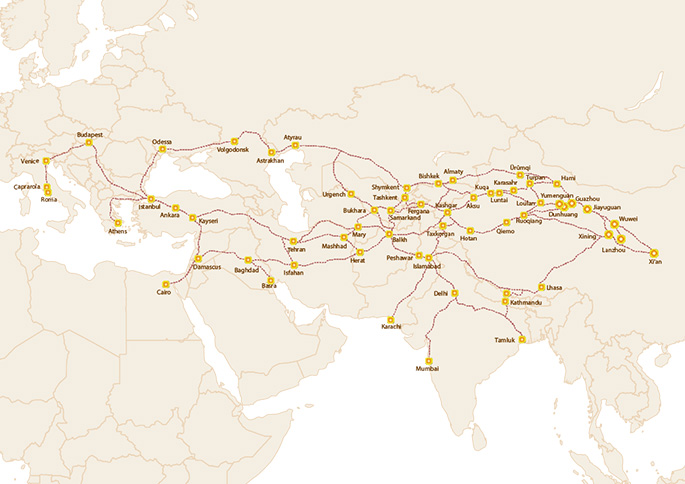The Silk Road (Chinese: 丝绸之路), first popularized by the German geographer Ferdinand von Richthofen in 1877, refers to a network of trade routes that stretched from central China to the Pamir, through central Asia and Arabia to India and Rome. The Silk Road was active from the 2nd century BC until the mid-15th century AD.
Spanning more than 6,400 kilometers across Eurasia, the Silk Road played a key role in facilitating exchanges in economy, culture, politics, and religions between East and West. The central part of the Silk Road, located in Arid Central Asia, is highly sensitive to environmental changes. The oasis routes have been active for 4000 years though precursors of the Silk Road date back nearly 5000 years and extended to the northern steppes of Central Eurasia. Early trans-Eurasia exchanges and the historical Silk Road reshaped the development of civilizations in Eurasia.


The Silk Road was an exceptional landmark of continental-scale exchanges throughout human history, spanning thousands of years across the vast landscapes of the Gobi Desert, oases, mountains, basins, forests, and steppes in Eurasia. The mechanisms of early human migrations in the paleolithic periods, agricultural dispersion in the neolithic periods, and civilization development along the Silk Road have attracted high interest from both social and natural scientists.
In 2018, the Ministry of Science and Technology in China (MOST) funded a key project to study the impacts of climate and hydrology changes on the Silk Road Civilization. Inspired by the achievements of this project, Prof. Fahu Chen at Institute of Tibetan Plateau Research, Chinese Academy of Sciences launched an ANSO (Alliance of International Science Organizations) association titled Trans-Eurasia Exchange and Silk Road Civilization Development (ATES) in 2019 to promote interdisciplinary studies along the Silk Road regions and beyond.
The launching of ATES establishes an international platform to exchange multi-discipline knowledge and the latest research achievements on the ancient Silk Road, including exchanges of culture, science and technology across the region perceptions of climate change and socio-economic development in different historical periods along the Silk Road, and effects of environmental changes on the rise and fall of the Silk Road civilization.
Prof. Fahu Chen, Chair of ATES (CAS member, TWAS member)
To deepen understanding of the interactions between environmental changes, long-term trans-Eurasia exchanges and Silk Road civilizations, by promoting interdisciplinary research of natural sciences, social sciences, and humanities across Eurasia.